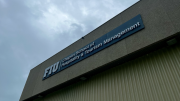Jonathan Szydlo/BBC Managing Editor
One thousand people gathered to march, demonstrate and chanted as one voice, “The people, united, will never be defeated.”
The crowd met on Oct. 15 on the sidewalk of Biscayne Boulevard, in front of the Torch of Friendship in Downtown Miami, brandishing signs representing various issues, but for the most part echoing the now global Occupy protests against the corporate influence on government.
As the protesters gathered waving signs and banners calling for workers’ rights, the forgiving of students loans, need over greed, and economic reform, cars driving by – including ambulances, fire trucks, and police cars – honked their horns in support of the gathering crowd, adding to the air of excitement.
As the crowd grew in numbers and gained momentum after a series of speeches and chants, the protesters began their march from the Torch of Friendship to the Stephen P. Clark Government Center to commence the third general assembly of the Occupy Miami movement.
The Occupy Miami protesters arrived at the Government Center and began to circle into a tightly packed boisterous group. As the final marchers arrived, and the momentum of the protest came to a climax, a female protester began to pitch a tent as the crowd gathered around her, officially beginning the occupation of Miami.
Those who attended, such as Danny Turkel, a senior political science and international relations major at the University, have high but restrained hopes for Occupy Miami and the movement as a whole.
“I really hope this raises awareness,” said Turkel. “I’m not that optimistic that I think tomorrow everything will be different, but I hope this ends up raising some sort of awareness where more people get out and things gradually change.”
Once the noise began to subside, members of the group began to stand up as facilitators to begin the discussion and protocols for the general assembly.
A system of hand gestures was established to maintain a degree of order among the crowd to represent signs of agreement, disagreement, having a question or wanting to give a direct response to a question posed to the assembly.
All who wanted to speak to the assembly of the more than 500 who remained after the march were able to do so as their words were repeated by the majority of those present.
Rain began to set in and some protesters decided to head home, but the general assembly sought shelter under an overhang at the entrance of the Government Center building, and continued to hear out proposals brought up by assembly members.
The third general assembly ended with less than a third of the people who turned out for the general protest that took place earlier in the day, and only a handful of tents set up on the west lawn of the government center, whose operating hours are from sunrise to sunset.
After Occupy Miami’s first night under the stars, what started out as a handful of tents began to expand into more than 20. One such tent was for first aid and was manned by Joan Valasek, a 27-year-old paramedic, and others who are or have been certified at one point in first aid and CPR. The distribution of food and water was also organized.
Throughout the night, there were only two instances in which medical attention was necessary, an injury one of the occupiers sustained while playing soccer and treatment to a laceration a man not related to Occupy Miami sustained after a homeless man assaulted him.
“When dealing with the homeless, it’s an inherent contradiction to the movement; we’re technically occupying the space that they have been occupying,” said Liz Weintraub, a University of Miami graduate student who set up her tent at 1:30 a.m.
Ramy Mahmoud, a University alumnus and a member of the Occupy Miami security team that is designated by yellow sashes, was encouraged by the support the movement was receiving through donations.
“There have been a lot of donations of food and water. At one point we were running low, but out of nowhere there was an enormous influx [of provisions],” said Mahmoud. “As people begin to see what we are starting to do here, they want to be a part of it and start contributing.”
Mother Nature matched the downpour of provisions Occupy Miami received with a literal downpour on the protesters’ second day. The second day, however, had a sense of organization as security teams were set up to warn occupiers if there was a police presence and to fend off anyone with hostile intentions, neither of which occurred.
Greg Glassman, 23, spent the first night out at the Government Center and was elated by the atmosphere surrounding Occupy Miami.
“It’s awesome, the fact that people decided to stay,” said Glassman. “There are a bunch of young people here. The numbers need to go up but the vibe here is still amazing.”
City of Miami police officers stopped by in uniform, whether on or off duty was not clear, to show their support for Occupy Miami, but also made it clear to those camping out that if the officers were ordered to remove the protesters, that they would have no choice but to do so.
With Occupy Miami having an average of 100 occupiers throughout its second day, some are weary of what’s to come, especially since they are occupying a piece of land whose hours of operation are from sunrise to sunset.
“I’m a little nervous with what’s to come,” said Weintraub. “We have sad numbers right now, and it’s too few people for us to have a significant presence if the police come to move us.”
Even a uniformed City of Miami police officer, who requested to not be named, admitted that with the start of the work week, Occupy Miami may be forced to move by the Miami-Dade Police Department, under whose jurisdiction the government center falls.
But as of Oct. 16, the relationship between Occupy Miami and the respective police departments has been amicable, as Miami-Dade College theater student Yuceidy Gonzalez admitted.
“We have to be respectful,” said Gonzalez. “Technically, we are engaged in active civil disobedience, but because we have been cooperating they have been good to us. What’s kind of ironic is that because the police station is open 24 hours, they have allowed us to use their restrooms throughout the night.”
Although the numbers are low, Occupy Miami protesters are looking forward to the coming days as the government center kicks off the work week.
A general assembly took place on Oct. 16 at 1:30 p.m. to see how Occupy Miami will proceed during the government center’s business hours. Gonzalez admitted Occupy Miami “can’t just protest, we need to be productive.”
But as Mahmoud explained, it’s hard to be productive when you don’t know what direction to take.
“It’s hard to explain why we are all here, because as a collective we don’t know, except that we are all frustrated with the way things are,” said Mahmoud. “Everyone wants to make moves and take action, but no one knows what to do.”








Be the first to comment on "Occupy movement makes its way to Miami"